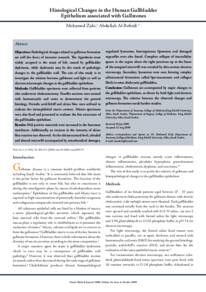Document
Histological changes in the human gallbladder epithelium associated with gallstones.
Contributors
Al-Refeidi, Abdullah., Author
Publisher
Oman Medical Specialty Board.
Gregorian
2009-10
Language
English
Subject
English abstract
Objectives: Pathological changes related to gallstone formation are still the focus of intensive research. The hypothesis most widely accepted is the stasis of bile caused by gallbladder dyskinesia, while dyskinesia may be the result of pathologic changes in the gallbladder wall. The aim of this study is to investigate the relation between gallstones and light as well as electron microscopic changes in the gallbladder epithelium.Methods: Gallbladder specimens were collected from patients who underwent cholectstectomy. Paraffin sections were stained with haematoxylin and eosin to demonstrate the general histology. Periodic acid-Schiff and alcian blue were utilized to evaluate the intraepithelial mucin content. Minute specimens were also fixed and processed to evaluate the fine structures of the gall bladder epithelium.Results: PAS positive materials were increased in the basement membrane. Additionally, an increase in the intensity of alcian blue reaction was observed. At the ultrastructural level, abraded and altered microvilli accompanied by mitochondrial damages, angulated lysosomes, heterogeneous liposomes and damaged organelles were also found. Complete collapse of intercellular spaces in the region above the tight junctions up to the bases of the marginal microvilli was revealed by thin-section electron microscopy. Secondary lysosomes were seen forming complex substructural formations called lipo-mucosomes and collagen fibrils in some cholecystic gallbladders.Conclusion: Gallstones are accompanied by major changes in the gallbladder epithelium, as shown by both light and electron microscopy. The relation between the observed changes and gallstone formation needs further studies.
Member of
Resource URL
Category
Journal articles

